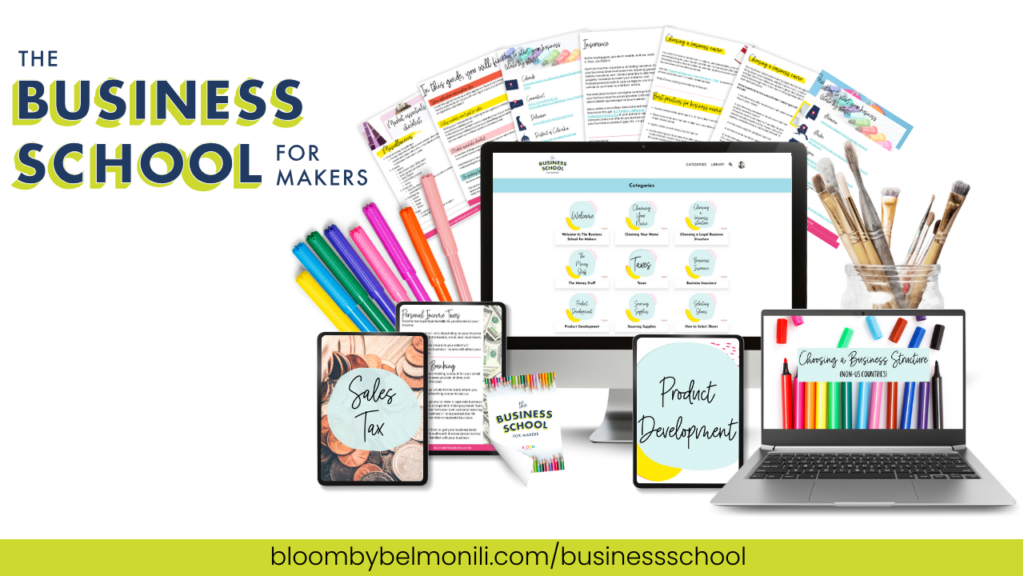Your go-to guide to mastering your in-person market experience
Freebie alert: Market Must-Haves for Makers
Blog Categories
An exclusive online membership for makers and creative business owners ready ditch the overwhelm and hustle for consistent sales and flexible schedules.
The Marketing School for Makers
Membership
Hi! I’m Lucy.
Chardonnay and vintage finds lover, founder of the handmade jewelry brand bel monili *and* your new guide to making your handmade business WORK online.
Hey, I'm Lucy
How to Create a Brand Board for Your Handmade Business
Filed under:
If you run a handmade business, your brand is not just a reflection of your products, but it’s a mirror to your values, aesthetics, and your unique story.
A brand board acts as a compass for your business’s visual identity, ensuring consistency across every touchpoint with customers.

Let’s go through the steps to create an effective brand board that resonates with both your identity and your audience.
Time to get started!
Disclosure: some of the links below are affiliate links, meaning, at no additional cost to you, I will earn a commission if you click through and make a purchase.
What is a Brand Board?
A brand board is a comprehensive document that displays all the visual elements of your brand in one cohesive presentation.
This typically includes your logo, color palette, typography, imagery, and other graphic elements.
It serves as a reference to maintain consistency in your branding across all marketing materials, from your website to packaging and beyond.

Step 1: Define Your Brand’s Core
The first step in creating a brand board is to define the core elements of your brand. This includes your mission statement, the vision for your business, and the values that guide your operations.
For instance, let’s consider a fictional handmade candle business named “Lumina Candles.” Their mission might be to provide eco-friendly, soothing home fragrances that enhance the wellbeing of their customers. Lumina’s vision could be to become a leading brand in sustainable home decor, while their values might emphasize sustainability, craftsmanship, and customer wellness.
Step 2: Develop Your Logo and Submarks
Your logo is often the first visual interaction people have with your brand, so it needs to represent your business effectively.
Submarks are variations of your main logo, used in different contexts. For our example, Lumina Candles might use a stylized “L” with a flame to signify warmth and light, with a circular submark for social media profiles and smaller prints.
Step 3: Select Your Color Palette
Colors can evoke emotions and convey messages without words. Choose colors that align with the mood and tone of your brand.
For Lumina Candles, soothing earth tones like soft greens, warm beiges, and deep browns could reflect their eco-friendly and calming products.

Step 4: Choose Your Fonts
The fonts you choose should complement your logo and color palette while being practical for everyday use.
Lumina Candles might choose a simple, clean sans-serif font like Poppins for digital platforms and an elegant serif font like Radley for product labeling to add a touch of sophistication.
Step 5: Incorporate Textures and Patterns
Textures and patterns can add depth and interest to your brand visuals. Choose elements and images that support your brand values, and that can be used in different ways.
For a business like Lumina Candles, incorporating a pattern of subtle leaf prints could enhance the natural aspect of the brand, suitable for use in backgrounds and as decorative elements on their website.
Step 6: Select Imagery
The images you choose should reflect the lifestyle or mood your brand promotes. Take photos of your products that can be used for marketing, such as groups of your pieces together, or collection photos.
Lumina Candles could use photographs of their candles in cozy, softly-lit room settings, which helps potential customers visualize the product in their own homes.

Step 7: Assemble Your Brand Board
Now, bring all these elements together into a single document. Canva has a great brand kit feature that helps with pulling all of this together. This should include:
- Logo and Submarks: Display your main logo and any secondary logos.
- Color Palette: Show your primary and secondary colors with Hex codes.
- Typography: Showcase the fonts used in your branding.
- Textures and Patterns: Include samples of any textures or patterns.
- Imagery: A selection of images that embodies your brand’s ethos.
Example: Handmade Jewelry Brand “Ela’s Elements”
To give another example, consider “Ela’s Elements,” a handmade jewelry brand that uses natural stones and recycled metals. Their brand board might feature:

- Logo: A minimalist design of a stone and metal intertwined.
- Color Palette: Deep blue and copper tones, reflecting the natural elements used in their jewelry.
- Typography: A combination of a strong, bold font for headings and a light, airy script for accents.
- Textures and Patterns: Hammered metal textures and watercolor backgrounds.
- Imagery: Photos of their jewelry pieces on natural wood backgrounds or being worn by people in natural settings.
Using Your Brand Board Effectively
Once your brand board is complete, use it as a blueprint for all your branding efforts.
Ensure that every piece of content you create, whether an Instagram post, a product tag, or your website design, aligns with the guidelines set out in your brand board.
This consistency is key to building a strong, recognizable brand.
How to Create a Brand Board for Your Handmade Business
Creating a brand board is a vital step for your handmade business, ensuring that your brand’s identity is the same across all touchpoints with your target audience.
By taking the time to carefully consider and compile the elements of your brand board, you set a solid foundation for your marketing efforts and help your business stand out in a crowded market.
Once you have your brand board ready, make sure that you’ve got all your business “ducks” in a row. My Business School for Makers will help you ensure all your legal and financial information is correct. Read more about the self-paced course and get started here!

Leave a Reply Cancel reply
You are in the right place, my creative friend!
After running bel monili (my handmade jewelry business) for 10 years, I launched Bloom in 2019 to create a community where handmade business owners could learn, grow, and support each other in this wild venture of small business ownership. Welcome to Bloom!
Join The MArketing School for Makers
follow
pin it
'Gram
watch
@bloombybelmonili